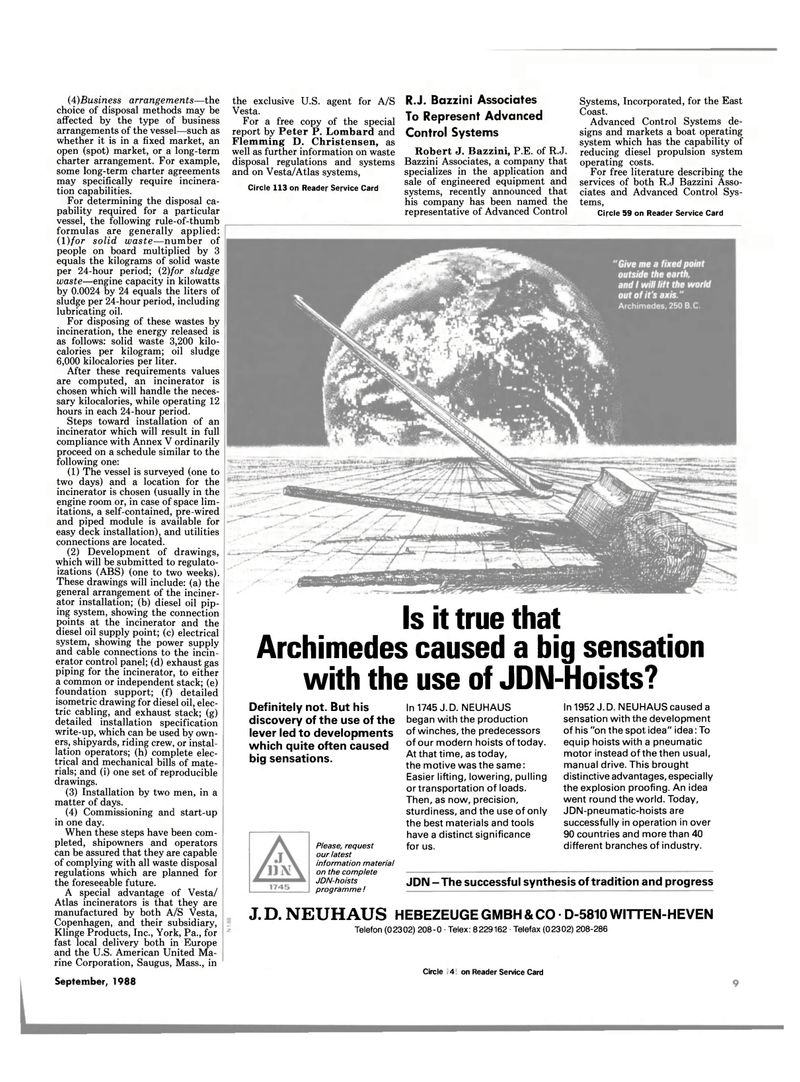
Page 7: of Maritime Reporter Magazine (September 1988)
Read this page in Pdf, Flash or Html5 edition of September 1988 Maritime Reporter Magazine
(4)Business arrangements—the choice of disposal methods may be affected by the type of business arrangements of the vessel—such as whether it is in a fixed market, an open (spot) market, or a long-term charter arrangement. For example, some long-term charter agreements may specifically require incinera- tion capabilities.
For determining the disposal ca- pability required for a particular vessel, the following rule-of-thumb formulas are generally applied: (1 )for solid waste—number of people on board multiplied by 3 equals the kilograms of solid waste per 24-hour period; (2)for sludge waste—engine capacity in kilowatts by 0.0024 by 24 equals the liters of sludge per 24-hour period, including lubricating oil.
For disposing of these wastes by incineration, the energy released is as follows: solid waste 3,200 kilo- calories per kilogram; oil sludge 6,000 kilocalories per liter.
After these requirements values are computed, an incinerator is chosen which will handle the neces- sary kilocalories, while operating 12 hours in each 24-hour period.
Steps toward installation of an incinerator which will result in full compliance with Annex V ordinarily proceed on a schedule similar to the following one: (1) The vessel is surveyed (one to two days) and a location for the incinerator is chosen (usually in the engine room or, in case of space lim- itations, a self-contained, pre-wired and piped module is available for easy deck installation), and utilities connections are located. (2) Development of drawings, which will be submitted to regulato- izations (ABS) (one to two weeks).
These drawings will include: (a) the general arrangement of the inciner- ator installation; (b) diesel oil pip- ing system, showing the connection points at the incinerator and the diesel oil supply point; (c) electrical system, showing the power supply and cable connections to the incin- erator control panel; (d) exhaust gas piping for the incinerator, to either a common or independent stack; (e) foundation support; (f) detailed isometric drawing for diesel oil, elec- tric cabling, and exhaust stack; (g) detailed installation specification write-up, which can be used by own- ers, shipyards, riding crew, or instal- lation operators; (h) complete elec- trical and mechanical bills of mate- rials; and (i) one set of reproducible drawings. (3) Installation by two men, in a matter of days. (4) Commissioning and start-up in one day.
When these steps have been com- pleted, shipowners and operators can be assured that they are capable of complying with all waste disposal regulations which are planned for the foreseeable future.
A special advantage of Vesta/
Atlas incinerators is that they are manufactured by both A/S Vesta,
Copenhagen, and their subsidiary,
Klinge Products, Inc., York, Pa., for fast local delivery both in Europe and the U.S. American United Ma- rine Corporation, Saugus, Mass., in
September, 1988 9 the exclusive U.S. agent for A/S
Vesta.
For a free copy of the special report by Peter P. Lombard and
Flemming D. Christensen, as well as further information on waste disposal regulations and systems and on Vesta/Atlas systems,
Circle 113 on Reader Service Card
R.J. Bazzini Associates
To Represent Advanced
Control Systems
Robert J. Bazzini, P.E. of R.J.
Bazzini Associates, a company that specializes in the application and sale of engineered equipment and systems, recently announced that his company has been named the representative of Advanced Control
Systems, Incorporated, for the East
Coast.
Advanced Control Systems de- signs and markets a boat operating system which has the capability of reducing diesel propulsion system operating costs.
For free literature describing the services of both R.J Bazzini Asso- ciates and Advanced Control Sys- tems,
Circle 59 on Reader Service Card
Is it true that Archimedes caused a big sensation with the use of JDN-Hoists?
Definitely not. But his discovery of the use of the lever led to developments which quite often caused big sensations.
Please, request our latest information material on the complete
JDN-hoists programme!
In 1745 J. D. NEUHAUS began with the production of winches, the predecessors of our modern hoists of today.
At that time, as today, the motive was the same:
Easier lifting, lowering, pulling or transportation of loads.
Then, as now, precision, sturdiness, and the use of only the best materials and tools have a distinct significance for us.
In 1952 J. D. NEUHAUS caused a sensation with the development of his "on the spot idea" idea: To equip hoists with a pneumatic motor instead of the then usual, manual drive. This brought distinctive advantages, especially the explosion proofing. An idea went round the world. Today,
JDN-pneumatic-hoists are successfully in operation in over 90 countries and more than 40 different branches of industry.
JDN - The successful synthesis of tradition and progress
J. D. NEUHAUS HEBEZEUGE GMBH & CO • D-5810 WITTEN-HEVEN
Telefon (02302) 208-0 • Telex: 8229162 Telefax (02302) 208-286
Circle 345 on Reader Service Card

 6
6

 8
8
